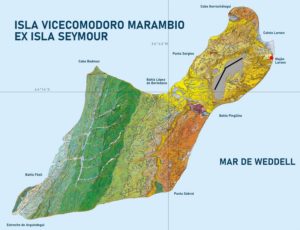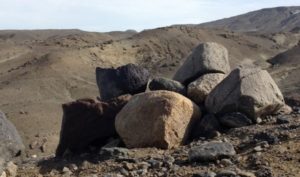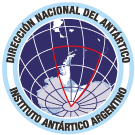Antarctica, a continent of ice and rock, was the last place on Earth to be discovered by humans, only two centuries ago, and remains almost completely uninhabited.
 Larsen cairn, 64°14’13” South and 56° 35′ 7″ West, is located 2 kilometers from the facilities of Marambio Base (WAP ARG-21)direction E-N-E (76˚) and 230 meters to the S-E-S of the Chavez lighthouse, 40 meters above sea level and 70 meters from the coast.
Larsen cairn, 64°14’13” South and 56° 35′ 7″ West, is located 2 kilometers from the facilities of Marambio Base (WAP ARG-21)direction E-N-E (76˚) and 230 meters to the S-E-S of the Chavez lighthouse, 40 meters above sea level and 70 meters from the coast.
Thanks to the joint work of Argentine scientists and diplomats, Larsen cairn will remain protected and disseminated as a new Antarctic Treaty Historic Site and Monument approved with nr. 94, on July 11 by the recent 42nd Antarctic Treaty Consultative Meeting from Argentina, Norway, Sweden and United Kingdom joint proposal, symbolizing the achievements of science and international cooperation, fundamental pillars of the Argentine Antarctic Program.
The “Cairn of Larsen” is a site where various expeditions from different countries at different times left messages of their passage through that remote place, while waiting for their rescue or looking for survivors. In this way, this new historical monument stands as a witness to the exploration of those regions, as well as Antarctic science, being a symbol of the birth of polar paleontology.
The history of the site begins in the summer 1892/3, when Norwegian Captain Carl Anton Larsen explores that region with the idea of extending the whaling industry to the South.
Larsen would then descend on what we know today as Vicecomodoro Marambio Island, in an area near the Argentine Base, leaving the first human footprints there. On that site, Larsen did collect some invertebrate fossils, which would later be the first in Antarctica to be studied. Before leaving, he installed a stone marker on the island with a two-meter post in which he wrote the year and the name of the expedition ship Jason.
 For this reason, the footprints of the first Antarctic pioneers have an extraordinary heritage value for all mankind. The historical sites of the sixth continent are so scarce, that, in all its extension, including the surrounding islands, we find less than one hundred of them, however, a new site has been added to that select list thanks to the work promoted by the Argentine Antarctic Program, promoted by the National Antarctic Directorate (DNA), through the Argentine Antarctic Institute (IAA).
For this reason, the footprints of the first Antarctic pioneers have an extraordinary heritage value for all mankind. The historical sites of the sixth continent are so scarce, that, in all its extension, including the surrounding islands, we find less than one hundred of them, however, a new site has been added to that select list thanks to the work promoted by the Argentine Antarctic Program, promoted by the National Antarctic Directorate (DNA), through the Argentine Antarctic Institute (IAA).
Read more at: http://www.marambio.aq/mojonlarsen.html
